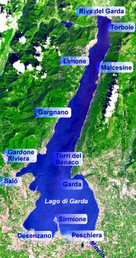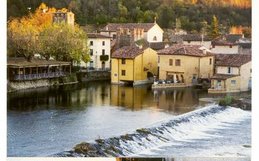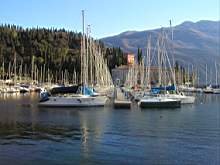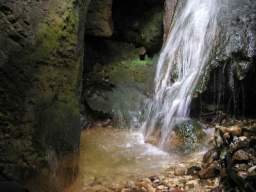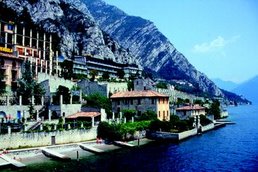
I princiapli venti del lago di Garda sono:
Peler: è un vento costante caratteristico del Lago di Garda, proveniente da Nord e che interessa quasi tutto il lago, soprattutto l'alto ed il medio Garda. Soffia dalle prime ore della notte (2-3) fino a circa mezzogiorno (11-12) e si rafforza dopo il sorgere del sole a causa dell'aumento della temperatura. Nella parte orientale del medio garda è un po' più forte ed in estate può raggiungere velocità fino a 15 m/s con conseguente formazione del moto ondoso. Viene sfruttato per la pratica del windsurf da numerosi appassionati che escono all'alba nei pressi di Limone o di Malcesine.
Ora: dal latino "aura" cioè "vento", è una brezza di valle proveniente dalla pianura Padana che spira da Sud poco dopo la caduta del Peler (12-13) sino al pomeriggio inoltrato. Interessa in maniera significativa il medio e soprattutto l'alto garda dove acquista velocità per effetto Venturi, dovuto alla paricolare conformazione a "forma di imbuto" del lago e delle montagne circostanti; il basso Garda risulta solitamente poco interessato, soprattutto nei mesi estivi. È meno intenso del Peler e dell'Ander, abitualmente raggiunge una velocità tra i 5-6 m/s anche se nei mesi estivi, nel quale è più intenso, può arrivare a velocità di 10-12 m/s originando un rilevante moto ondoso soprattutto nell'alto Garda. Viene sfruttato nelle ore pomeridiane da catamarani, windsurf e barche a vela che navigano nelle acque all'altezza di Torbole.
Ponal: è un vento tipicamente estivo e di forte intensità. Soffia dalla valle di Ledro nelle ore mattutine e nelle ore serali seguendo il solco del torrente Ponale da cui ne deriva il nome.
Bali o Balinot o anche Spisoca: è un vento proveniente da Nord tipicamente invernale, originato da un forte abbassamento della temparatura spesso dovuto ad intense precipitazioni a carattere nevoso. Può raggiungere velocità fino a 20 m/s e dare luogo ad un forte moto ondoso.
Ander: è un vento costante proveniente da Sud-Ovest che spira nel primo pomeriggio e che si protrae solo per poche ore interessando soprattutto il Basso Garda. A volte può però raggiungere l'alto Garda e soffiare anche di notte. Può raggiungere velocità fino a 10 m/s dando luogo ad onde irregolari soprattutto da metà lago in su.
Vinesa: è un vento costante proveniente da Est Sud-Est e che soffia dalla sponda veronese verso quella bresciana. È dovuto a perturbazioni in corso nell'alto Adriatico o all'insorgenza della Bora; in tal caso se il cielo a Est Sud-Est di Peschiera diventa di colore scuro, si preannucia l'arrivo di questo vento portatore di mal tempo. Può essere molto pericoloso per la sua forza e per il moto ondoso che origina.
Boaren o Boarno: è una brezza di terra proveniente da Vobarno (da cui il nome) in Val Sabbia e che spira al mattino o alla sera da Ovest Nord-Ovest uscendo dal Golfo di Salò e allontandno il Peler dal Golfo di Toscolano-Maderno. È di varia intensità con una velocità massima che può arrivare 5-6 m/s anche se solitamente è debole e pertanto non riesce a lambire la sponda veronese ne causare moto ondoso. È un vento che solitamente porta bel tempo.
Gardesana: è un vento spira da Garda in direzione di Sirmione .
Visentina: è un vento originato dal maltempo che scende da San Vigilio interessando il basso Garda.
Fasanella: è un vento costante, solitamente di scarsa intensità, che si forma nel primo pomeriggio ad ovest di Fasano (fraz. Gardone Riviera) e soffia verso est fino al tramondo, raggiungendo anche il basso Garda. Può anche incanalarsi verso l'alto Garda ed acquistare forza per effetto Venturi, originando moto ondoso a partire da Tignale. È tipico del periodo estivo, porta bel tempo e rende il lago di color verde azzurro.
Peler: è un vento costante caratteristico del Lago di Garda, proveniente da Nord e che interessa quasi tutto il lago, soprattutto l'alto ed il medio Garda. Soffia dalle prime ore della notte (2-3) fino a circa mezzogiorno (11-12) e si rafforza dopo il sorgere del sole a causa dell'aumento della temperatura. Nella parte orientale del medio garda è un po' più forte ed in estate può raggiungere velocità fino a 15 m/s con conseguente formazione del moto ondoso. Viene sfruttato per la pratica del windsurf da numerosi appassionati che escono all'alba nei pressi di Limone o di Malcesine.
Ora: dal latino "aura" cioè "vento", è una brezza di valle proveniente dalla pianura Padana che spira da Sud poco dopo la caduta del Peler (12-13) sino al pomeriggio inoltrato. Interessa in maniera significativa il medio e soprattutto l'alto garda dove acquista velocità per effetto Venturi, dovuto alla paricolare conformazione a "forma di imbuto" del lago e delle montagne circostanti; il basso Garda risulta solitamente poco interessato, soprattutto nei mesi estivi. È meno intenso del Peler e dell'Ander, abitualmente raggiunge una velocità tra i 5-6 m/s anche se nei mesi estivi, nel quale è più intenso, può arrivare a velocità di 10-12 m/s originando un rilevante moto ondoso soprattutto nell'alto Garda. Viene sfruttato nelle ore pomeridiane da catamarani, windsurf e barche a vela che navigano nelle acque all'altezza di Torbole.
Ponal: è un vento tipicamente estivo e di forte intensità. Soffia dalla valle di Ledro nelle ore mattutine e nelle ore serali seguendo il solco del torrente Ponale da cui ne deriva il nome.
Bali o Balinot o anche Spisoca: è un vento proveniente da Nord tipicamente invernale, originato da un forte abbassamento della temparatura spesso dovuto ad intense precipitazioni a carattere nevoso. Può raggiungere velocità fino a 20 m/s e dare luogo ad un forte moto ondoso.
Ander: è un vento costante proveniente da Sud-Ovest che spira nel primo pomeriggio e che si protrae solo per poche ore interessando soprattutto il Basso Garda. A volte può però raggiungere l'alto Garda e soffiare anche di notte. Può raggiungere velocità fino a 10 m/s dando luogo ad onde irregolari soprattutto da metà lago in su.
Vinesa: è un vento costante proveniente da Est Sud-Est e che soffia dalla sponda veronese verso quella bresciana. È dovuto a perturbazioni in corso nell'alto Adriatico o all'insorgenza della Bora; in tal caso se il cielo a Est Sud-Est di Peschiera diventa di colore scuro, si preannucia l'arrivo di questo vento portatore di mal tempo. Può essere molto pericoloso per la sua forza e per il moto ondoso che origina.
Boaren o Boarno: è una brezza di terra proveniente da Vobarno (da cui il nome) in Val Sabbia e che spira al mattino o alla sera da Ovest Nord-Ovest uscendo dal Golfo di Salò e allontandno il Peler dal Golfo di Toscolano-Maderno. È di varia intensità con una velocità massima che può arrivare 5-6 m/s anche se solitamente è debole e pertanto non riesce a lambire la sponda veronese ne causare moto ondoso. È un vento che solitamente porta bel tempo.
Gardesana: è un vento spira da Garda in direzione di Sirmione .
Visentina: è un vento originato dal maltempo che scende da San Vigilio interessando il basso Garda.
Fasanella: è un vento costante, solitamente di scarsa intensità, che si forma nel primo pomeriggio ad ovest di Fasano (fraz. Gardone Riviera) e soffia verso est fino al tramondo, raggiungendo anche il basso Garda. Può anche incanalarsi verso l'alto Garda ed acquistare forza per effetto Venturi, originando moto ondoso a partire da Tignale. È tipico del periodo estivo, porta bel tempo e rende il lago di color verde azzurro.
The principal winds of the lago of Garda are:
Peler: it is characteristic a constant wind of the Lago of Garda, coming from from North and that it interests nearly all the lago, above all the high and the Garda mean. It blows from the first hours of night (2-3) until approximately noon (11-12) and it is strengthened after rising of the sun because of the increase of the temperature. In the part it orients them of the mean garda is a little more fort and in summer it can catch up speed until 15 m/s with consequent formation of the ondoso motion. It comes taken advantage of for the practical one of the windsurf from numerous gets passionate you that they exit to the dawn near Lemon or of Malcesine.
Ora: from the Latin “aura” that is “wind”, is a valley breeze them coming from from the Po plain that coil from South little after the fall of Peler (12-13) until to the advanced afternoon. It interests in meaningful way the mean above all and the high garda where it acquires speed for effect Lucks, had to paricolare conformation to “shape of funnel” of the lago and surrounding mountains; the low Garda usually turns out little interested, above all in the summery months. It is less intense of the Peler and of the Ander, habitually it catches up a speed between the 5-6 m/s even if in the summery months, in which it is more intense, it can arrive above all to speed of 10-12 m/s originating an important ondoso motion in the Garda high. It comes taken advantage of in the afternoon hours from catamarans, windsurf and sailing boats that are annoying in waters to the height of Torbole.
Ponal: it is a typically summery wind and strongly intensity. It blows from goes them of Ledro in the hours early risers and in the serali hours following I furrow of the Ponale torrent from which the name derives some. Bali or Balinot or also Spisoca: it is a coming from wind from typically winter North, originated from a strong lowering of the often which had temparatura to intense precipitations to snowy character. He can catch up speed until 20 m/s and giving rise to a strong ondoso motion.
Ander: it is a coming from constant wind from South-West that coil in the early afternoon and that protrae only for little hours being interested above all the Low Garda. Sometimes it can but catch up the Garda high and blow also of night. It can catch up speed until 10 m/s giving to place to irregular waves above all from half lago in on.
Vinesa: it is a coming from constant wind from East South-East and that it blows from the veronese side towards that bresciana. It has had to perturbations in course in the high Adriatic or to the insorgence of the Bora; in such case if the sky to East South-East of Fish farm becomes of dark color, preannucia the arrival of this wind bearer badly time. It can be much dangerous one for its force and the ondoso motion that originates.
Boaren or Boarno: coming from land breeze from Vobarno is one (from which the name) in Val Sabbia and that coil to mattino or the evening from the North-West West exiting from the Gulf of Salò and allontandno the Peler from the Gulf of Toscolano-Maderno. It is of varied intensity with the maximum speed that can arrive 5-6 m/s even if usually is weak person and therefore it does not succeed in lambire the veronese side of to cause ondoso motion. It is a wind that usually door beautiful time.
Gardesana: it is a wind coil from Garda in direction of Sirmione.
Visentina: it is a wind originated from the maltempo that the low Garda comes down from Saint Vigilio interesting.
Fasanella: it is a constant wind, usually of insufficient intensity, than shape in the early afternoon to the west of Fasano (fraz. Gardone Riviera) and blows towards east until the tramondo, catching up also the low Garda. It can also be channeled towards the Garda high and acquire force for effect beginning from Lucks, originating ondoso motion Tignale. It is typical of the summery period, door beautiful time and renders the lago of color green blue.














